2009 FIAT SEDICI lock
[x] Cancel search: lockPage 178 of 270
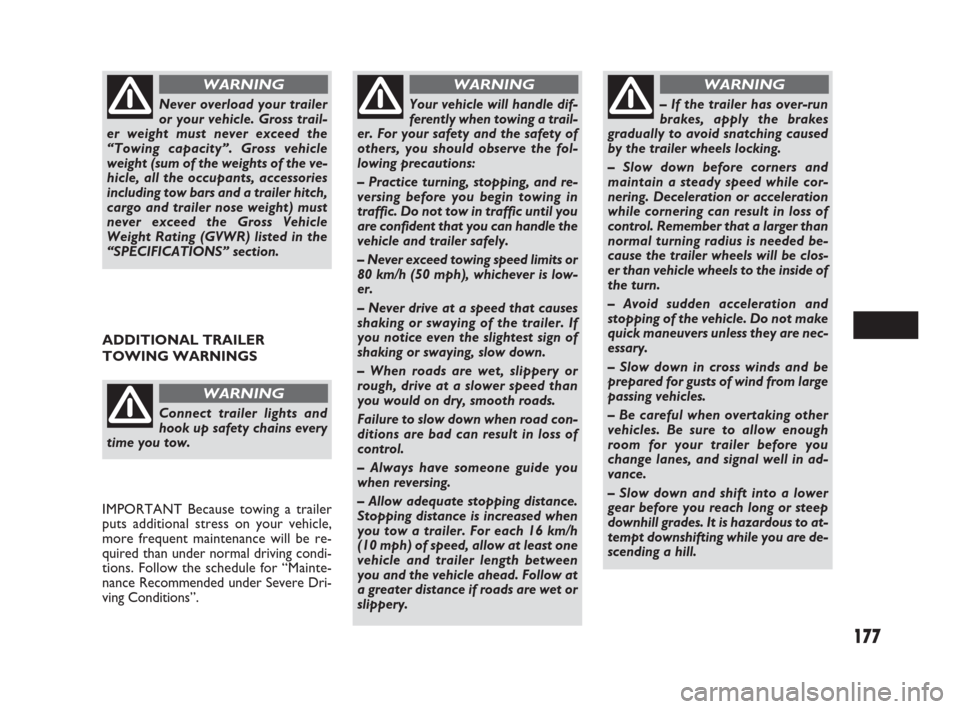
177
ADDITIONAL TRAILER
TOWING WARNINGS
Never overload your trailer
or your vehicle. Gross trail-
er weight must never exceed the
“Towing capacity”. Gross vehicle
weight (sum of the weights of the ve-
hicle, all the occupants, accessories
including tow bars and a trailer hitch,
cargo and trailer nose weight) must
never exceed the Gross Vehicle
Weight Rating (GVWR) listed in the
“SPECIFICATIONS” section.
WARNING
Connect trailer lights and
hook up safety chains every
time you tow.
WARNING
IMPORTANT Because towing a trailer
puts additional stress on your vehicle,
more frequent maintenance will be re-
quired than under normal driving condi-
tions. Follow the schedule for “Mainte-
nance Recommended under Severe Dri-
ving Conditions”.
Your vehicle will handle dif-
ferently when towing a trail-
er. For your safety and the safety of
others, you should observe the fol-
lowing precautions:
– Practice turning, stopping, and re-
versing before you begin towing in
traffic. Do not tow in traffic until you
are confident that you can handle the
vehicle and trailer safely.
– Never exceed towing speed limits or
80 km/h (50 mph), whichever is low-
er.
– Never drive at a speed that causes
shaking or swaying of the trailer. If
you notice even the slightest sign of
shaking or swaying, slow down.
– When roads are wet, slippery or
rough, drive at a slower speed than
you would on dry, smooth roads.
Failure to slow down when road con-
ditions are bad can result in loss of
control.
– Always have someone guide you
when reversing.
– Allow adequate stopping distance.
Stopping distance is increased when
you tow a trailer. For each 16 km/h
(10 mph) of speed, allow at least one
vehicle and trailer length between
you and the vehicle ahead. Follow at
a greater distance if roads are wet or
slippery.
WARNING
– If the trailer has over-run
brakes, apply the brakes
gradually to avoid snatching caused
by the trailer wheels locking.
– Slow down before corners and
maintain a steady speed while cor-
nering. Deceleration or acceleration
while cornering can result in loss of
control. Remember that a larger than
normal turning radius is needed be-
cause the trailer wheels will be clos-
er than vehicle wheels to the inside of
the turn.
– Avoid sudden acceleration and
stopping of the vehicle. Do not make
quick maneuvers unless they are nec-
essary.
– Slow down in cross winds and be
prepared for gusts of wind from large
passing vehicles.
– Be careful when overtaking other
vehicles. Be sure to allow enough
room for your trailer before you
change lanes, and signal well in ad-
vance.
– Slow down and shift into a lower
gear before you reach long or steep
downhill grades. It is hazardous to at-
tempt downshifting while you are de-
scending a hill.
WARNING
173-182 SEDICI LUM FL GB 1E 19-06-2009 10:49 Pagina 177
Page 182 of 270
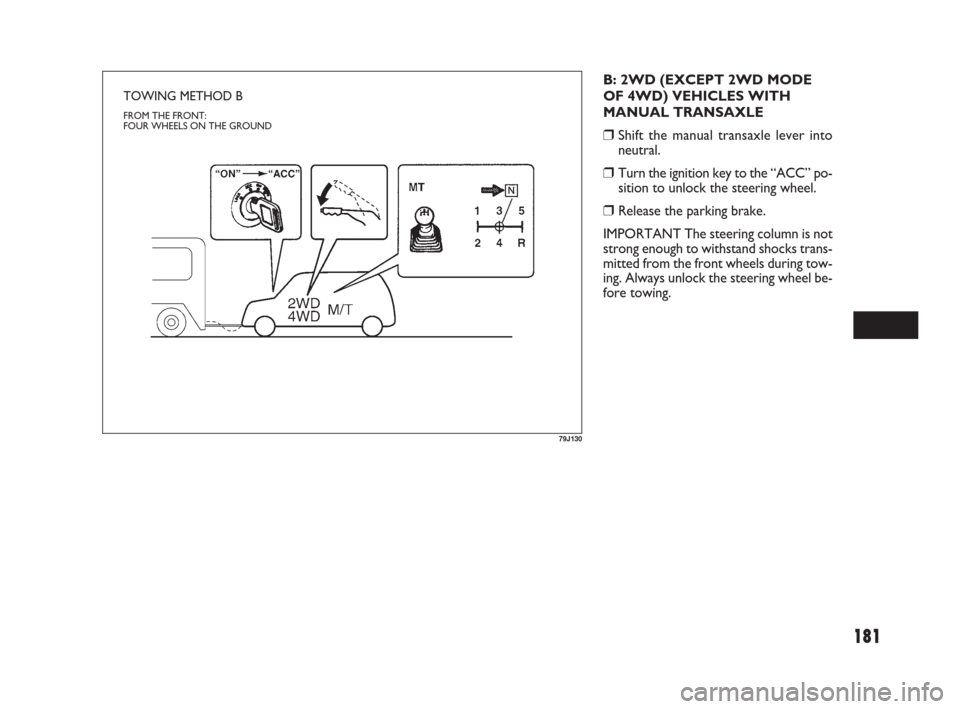
181
79J130
TOWING METHOD B
FROM THE FRONT:
FOUR WHEELS ON THE GROUND
B: 2WD (EXCEPT 2WD MODE
OF 4WD) VEHICLES WITH
MANUAL TRANSAXLE
❒Shift the manual transaxle lever into
neutral.
❒Turn the ignition key to the “ACC” po-
sition to unlock the steering wheel.
❒Release the parking brake.
IMPORTANT The steering column is not
strong enough to withstand shocks trans-
mitted from the front wheels during tow-
ing. Always unlock the steering wheel be-
fore towing.
173-182 SEDICI LUM FL GB 1E 19-06-2009 10:49 Pagina 181
Page 183 of 270
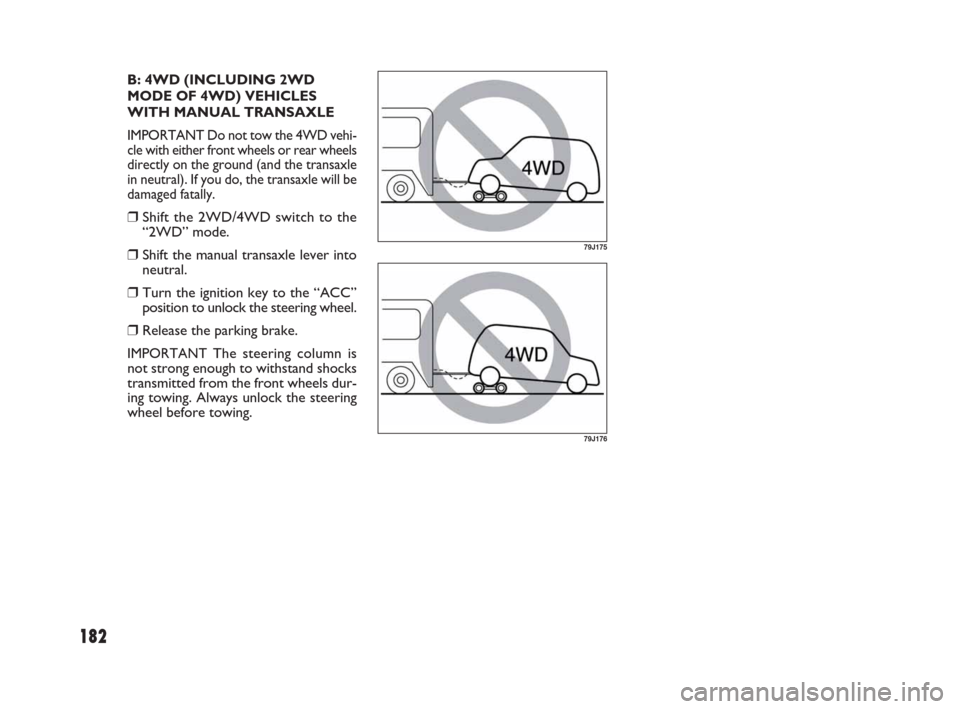
182
B: 4WD (INCLUDING 2WD
MODE OF 4WD) VEHICLES
WITH MANUAL TRANSAXLE
IMPORTANT Do not tow the 4WD vehi-
cle with either front wheels or rear wheels
directly on the ground (and the transaxle
in neutral). If you do, the transaxle will be
damaged fatally.
❒Shift the 2WD/4WD switch to the
“2WD” mode.
❒Shift the manual transaxle lever into
neutral.
❒Turn the ignition key to the “ACC”
position to unlock the steering wheel.
❒Release the parking brake.
IMPORTANT The steering column is
not strong enough to withstand shocks
transmitted from the front wheels dur-
ing towing. Always unlock the steering
wheel before towing.
79J175
79J176
173-182 SEDICI LUM FL GB 1E 19-06-2009 10:49 Pagina 182
Page 185 of 270
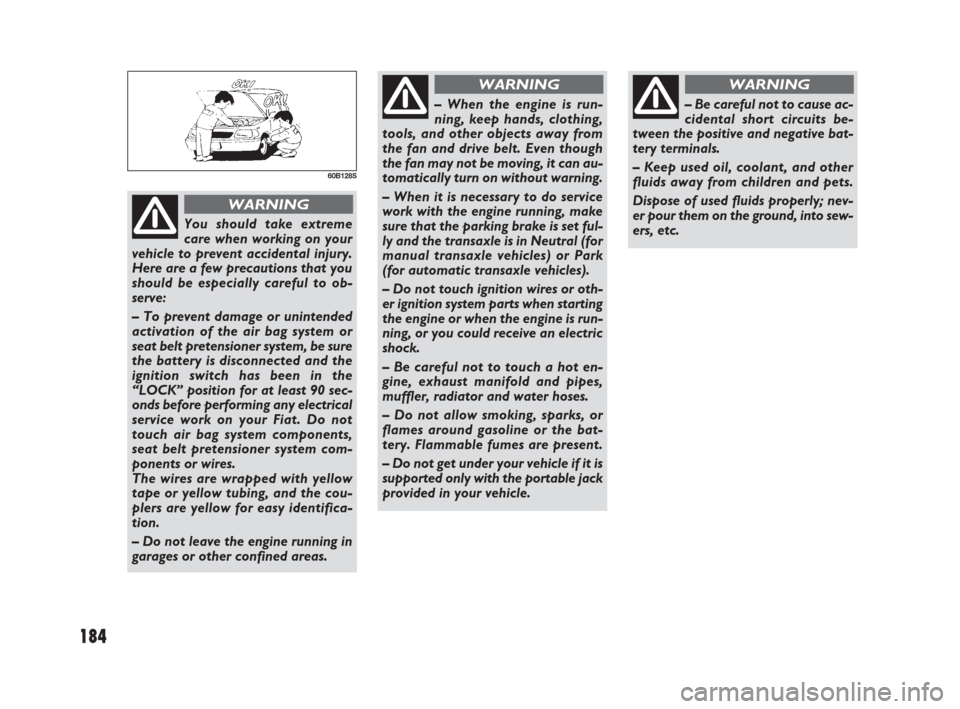
184
60B128S
You should take extreme
care when working on your
vehicle to prevent accidental injury.
Here are a few precautions that you
should be especially careful to ob-
serve:
– To prevent damage or unintended
activation of the air bag system or
seat belt pretensioner system, be sure
the battery is disconnected and the
ignition switch has been in the
“LOCK” position for at least 90 sec-
onds before performing any electrical
service work on your Fiat. Do not
touch air bag system components,
seat belt pretensioner system com-
ponents or wires.
The wires are wrapped with yellow
tape or yellow tubing, and the cou-
plers are yellow for easy identifica-
tion.
– Do not leave the engine running in
garages or other confined areas.
WARNING
– When the engine is run-
ning, keep hands, clothing,
tools, and other objects away from
the fan and drive belt. Even though
the fan may not be moving, it can au-
tomatically turn on without warning.
– When it is necessary to do service
work with the engine running, make
sure that the parking brake is set ful-
ly and the transaxle is in Neutral (for
manual transaxle vehicles) or Park
(for automatic transaxle vehicles).
– Do not touch ignition wires or oth-
er ignition system parts when starting
the engine or when the engine is run-
ning, or you could receive an electric
shock.
– Be careful not to touch a hot en-
gine, exhaust manifold and pipes,
muffler, radiator and water hoses.
– Do not allow smoking, sparks, or
flames around gasoline or the bat-
tery. Flammable fumes are present.
– Do not get under your vehicle if it is
supported only with the portable jack
provided in your vehicle.
WARNING
– Be careful not to cause ac-
cidental short circuits be-
tween the positive and negative bat-
tery terminals.
– Keep used oil, coolant, and other
fluids away from children and pets.
Dispose of used fluids properly; nev-
er pour them on the ground, into sew-
ers, etc.
WARNING
183-230 SEDICI LUM FL GB 1E 19-06-2009 11:00 Pagina 184
Page 188 of 270

187
15 30 45 60 75 90 105 120 135 150 165 180
●●●●●●●●●●●●
●●●●
●●●●●●●●●●●●
●● ●● ●● ●●
●●●●
●●●●
●●
●●●●
●
●● ●●●
●●●●
●
●●●●●●
●● ●●
●
●● ●●●●
●● ●●●●
●● ●●●●
●● ●●●●
●● ●●●●
Thousands of km
Check cleanliness of locks, bonnet and boot, and cleanliness
and lubrication of linkages
Replace spark plugs (replace iridium spark plugs
every 105,000 km) or every 7 years
Change engine oil and oil filter
Check air cleaner conditions
Replace air filter cartridge
Change engine coolant
Replace auxiliary drive belt
Sight inspect fuel tank conditions
Check manual transaxle gear oil level
Check automatic transaxle gear oil level
Change manual transaxle gear oil
Change automatic transaxle gear oil
Check transmission unit oil level (4x4 version)
Check rear differential oil level (4x4 version)
Change rear differential oil (4x4 version)
(just the first time at 15,000 km)
Check suspension operation
Check steering system
Check engine management system operation
(via diagnostic socket)
Change brake and clutch fluid (or every 2 years)
Replace pollen filter (or every 2 years)
183-230 SEDICI LUM FL GB 1E 19-06-2009 11:00 Pagina 187
Page 189 of 270
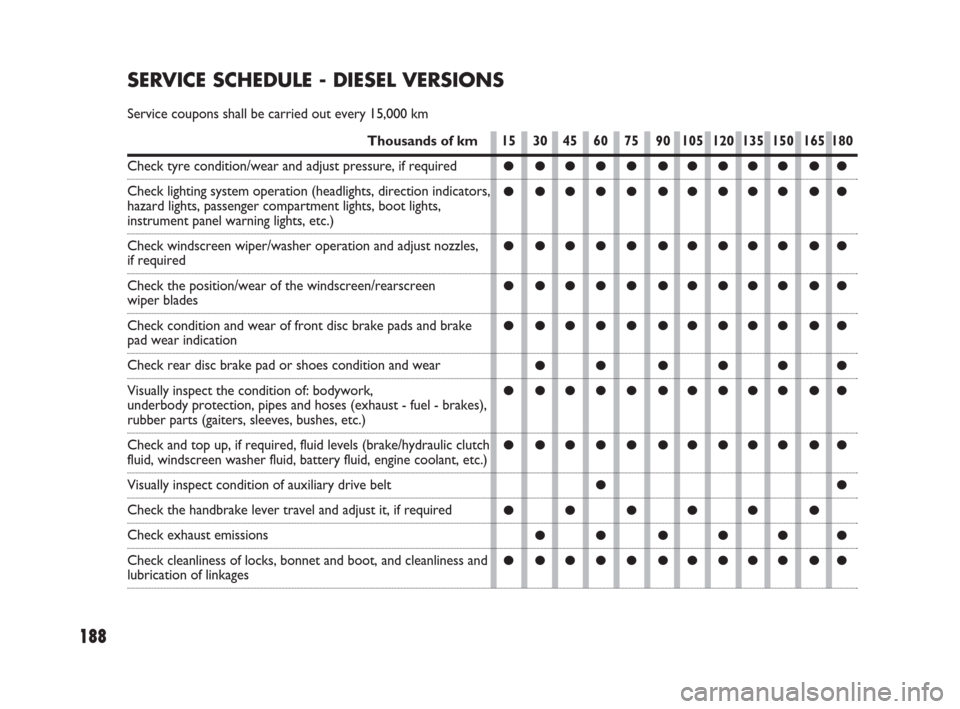
188
15 30 45 60 75 90 105 120 135 150 165 180
●●●●●●●●●●●●
●●●●●●●●●●●●
●●●●●●●●●●●●
●●●●●●●●●●●●
●●●●●●●●●●●●
●● ●●●●
●●●●●●●●●●●●
●●●●●●●●●●●●
●●
●●●●●●
●● ●●●●
●●●●●●●●●●●●
SERVICE SCHEDULE - DIESEL VERSIONS
Service coupons shall be carried out every 15,000 km
Thousands of km
Check tyre condition/wear and adjust pressure, if required
Check lighting system operation (headlights, direction indicators,
hazard lights, passenger compartment lights, boot lights,
instrument panel warning lights, etc.)
Check windscreen wiper/washer operation and adjust nozzles,
if required
Check the position/wear of the windscreen/rearscreen
wiper blades
Check condition and wear of front disc brake pads and brake
pad wear indication
Check rear disc brake pad or shoes condition and wear
Visually inspect the condition of: bodywork,
underbody protection, pipes and hoses (exhaust - fuel - brakes),
rubber parts (gaiters, sleeves, bushes, etc.)
Check and top up, if required, fluid levels (brake/hydraulic clutch
fluid, windscreen washer fluid, battery fluid, engine coolant, etc.)
Visually inspect condition of auxiliary drive belt
Check the handbrake lever travel and adjust it, if required
Check exhaust emissions
Check cleanliness of locks, bonnet and boot, and cleanliness and
lubrication of linkages
183-230 SEDICI LUM FL GB 1E 19-06-2009 11:00 Pagina 188
Page 195 of 270
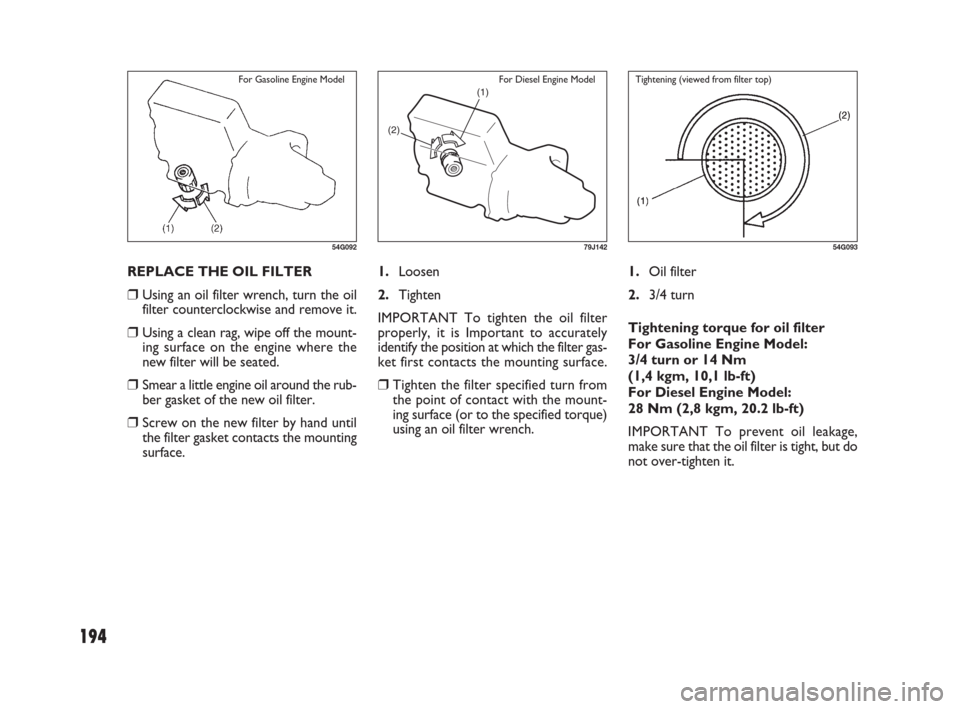
194
1.Oil filter
2.3/4 turn
Tightening torque for oil filter
For Gasoline Engine Model:
3/4 turn or 14 Nm
(1,4 kgm, 10,1 lb-ft)
For Diesel Engine Model:
28 Nm (2,8 kgm, 20.2 lb-ft)
IMPORTANT To prevent oil leakage,
make sure that the oil filter is tight, but do
not over-tighten it. REPLACE THE OIL FILTER
❒Using an oil filter wrench, turn the oil
filter counterclockwise and remove it.
❒Using a clean rag, wipe off the mount-
ing surface on the engine where the
new filter will be seated.
❒Smear a little engine oil around the rub-
ber gasket of the new oil filter.
❒Screw on the new filter by hand until
the filter gasket contacts the mounting
surface.
54G09254G093
Tightening (viewed from filter top)
1.Loosen
2.Tighten
IMPORTANT To tighten the oil filter
properly, it is Important to accurately
identify the position at which the filter gas-
ket first contacts the mounting surface.
❒Tighten the filter specified turn from
the point of contact with the mount-
ing surface (or to the specified torque)
using an oil filter wrench.
(1)
(2)
79J142
For Gasoline Engine Model For Diesel Engine Model
183-230 SEDICI LUM FL GB 1E 19-06-2009 11:00 Pagina 194
Page 200 of 270
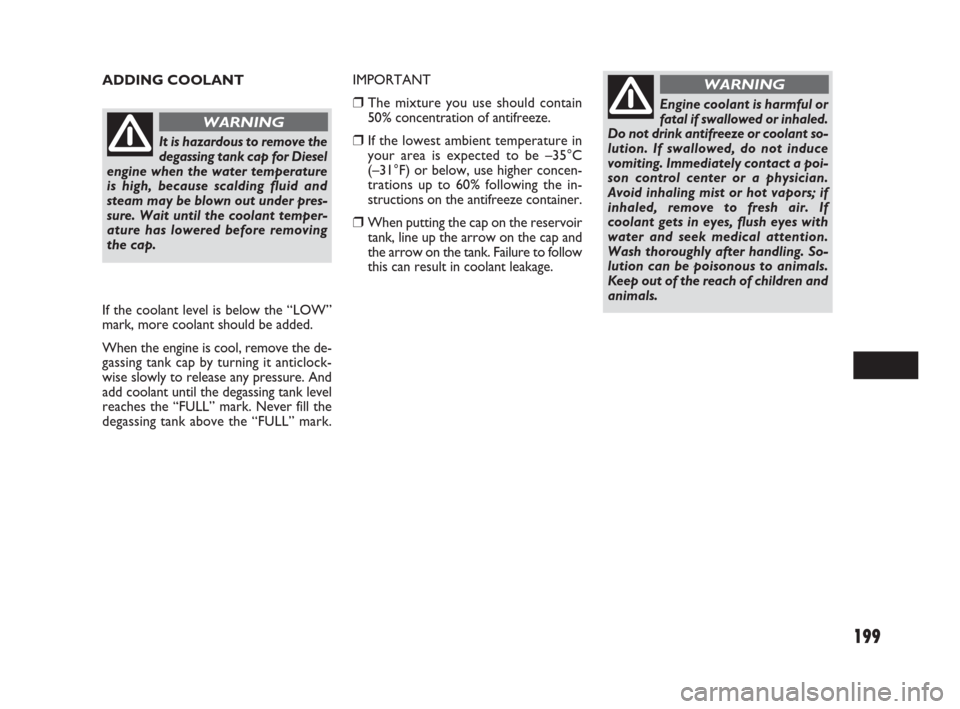
199
ADDING COOLANT
Engine coolant is harmful or
fatal if swallowed or inhaled.
Do not drink antifreeze or coolant so-
lution. If swallowed, do not induce
vomiting. Immediately contact a poi-
son control center or a physician.
Avoid inhaling mist or hot vapors; if
inhaled, remove to fresh air. If
coolant gets in eyes, flush eyes with
water and seek medical attention.
Wash thoroughly after handling. So-
lution can be poisonous to animals.
Keep out of the reach of children and
animals.
WARNINGIMPORTANT
❒The mixture you use should contain
50% concentration of antifreeze.
❒If the lowest ambient temperature in
your area is expected to be –35°C
(–31°F) or below, use higher concen-
trations up to 60% following the in-
structions on the antifreeze container.
❒When putting the cap on the reservoir
tank, line up the arrow on the cap and
the arrow on the tank. Failure to follow
this can result in coolant leakage.
If the coolant level is below the “LOW”
mark, more coolant should be added.
When the engine is cool, remove the de-
gassing tank cap by turning it anticlock-
wise slowly to release any pressure. And
add coolant until the degassing tank level
reaches the “FULL” mark. Never fill the
degassing tank above the “FULL” mark.
It is hazardous to remove the
degassing tank cap for Diesel
engine when the water temperature
is high, because scalding fluid and
steam may be blown out under pres-
sure. Wait until the coolant temper-
ature has lowered before removing
the cap.
WARNING
183-230 SEDICI LUM FL GB 1E 19-06-2009 11:00 Pagina 199